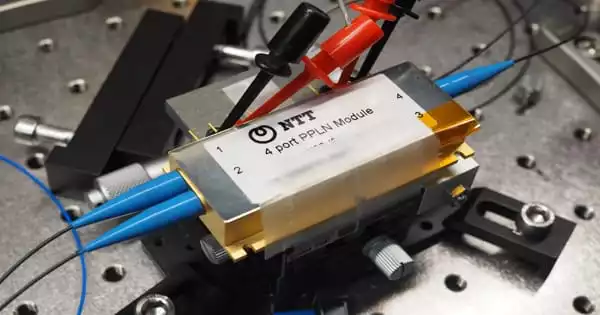Researchers used a modular waveguide-based light source to effectively generate strongly nonclassical light. Researchers were able to produce light in a superposition of coherent states by combining a waveguide optical parametric amplifier (OPA) module built for quantum experiments and a specifically designed photon detector. The accomplishment is a critical step toward speedier and more realistic optical quantum computers.
Researchers have successfully generated strongly nonclassical light for the first time using a modular waveguide-based light source. The accomplishment is a critical step toward speedier and more realistic optical quantum computers.
Using a modular waveguide-based light source, researchers at the University of Tokyo created significantly nonclassical light. The demonstration, which the researchers claim is the first of its sort, is expected to boost future efforts to develop faster and more practical optical quantum computers. The multiple quantum states required for quantum computing are generated using continuous-wave squeezed light.
“Our goal is to greatly increase information processing by constructing faster quantum computers that can execute any type of computing without errors,” stated University of Tokyo researcher Kan Takase. “While there are various approaches to building a quantum computer, light-based approaches seem promising since the information processor can work at ambient temperature and the processing scale can be easily scaled.”
Our technology for producing quantum light can be used to boost the computing capability of quantum computers and make the information processor more compact. Our technology outperforms traditional methods, and the modular waveguide OPA is simple to use and integrate into quantum computers.
Kan Takase
A multi-institutional team of Japanese researchers describes the waveguide optical parametric amplifier (OPA) module they developed for quantum experiments in the Optica Publishing Group journal Optics Express. Using this technology in conjunction with a specially built photon detector, they were able to create a state of light known as the Schrödinger cat, which is a superposition of coherent states.
“Our technology for producing quantum light can be used to boost the computing capability of quantum computers and make the information processor more compact,” Takase explained. “Our technology outperforms traditional methods, and the modular waveguide OPA is simple to use and integrate into quantum computers.”
Generating strongly nonclassical light
Continuous wave squeezed light is utilized to generate the multiple quantum states required for quantum computing. For optimal computing performance, the compressed light source must have very low levels of light loss and be wideband, encompassing a wide range of frequencies.
“We intend to boost the clock frequency of optical quantum computers, which can theoretically attain Terahertz frequencies,” Takase explained. “Higher clock frequencies enable faster execution of computing activities and allow the delay lines in optical circuits to be shortened. This allows optical quantum computers to be more compact while also making the overall system easier to create and stabilize.”

OPAs generate squeezed light using nonlinear optical crystals, but traditional OPAs do not generate quantum light with the qualities required for faster quantum computing. To address this issue, researchers at the University of Tokyo and NTT Corporation created an OPA based on a waveguide-type device that achieves great efficiency by restricting light to a narrow crystal.
They were able to develop an OPA device with considerably lower propagation loss than typical devices by carefully designing the waveguide and fabricating it with precision processing. It can also be modularized for use in a variety of quantum-technology studies.
The OPA device was created to produce squeezed light at telecommunications wavelengths, a wavelength area with low losses. Researchers needed a high-performance photon detector that functioned at telecom wavelengths to complete the system. Standard photon detectors based on semiconductors, on the other hand, do not meet the performance criteria for this application.
As a result, researchers from the University of Tokyo and the National Institute of Information and Communications Technology (NICT) created a detector specifically built for quantum optics. To detect photons, the novel superconducting nanostrip photon detector (SNSPD) employs superconductivity technology.
Takase explained, “We paired our novel waveguide OPA with this photon detector to achieve a very non-classical – or quantum – form of light termed Schrödinger cat. Generating this state, which is challenging with conventional, low-efficiency waveguide OPAs, validates our waveguide OPA’s high performance and opens the door to exploiting this device for a wide range of quantum studies.”
To achieve their objective of ultrafast optical quantum computing, the researchers are now investigating how to combine high-speed measurement techniques with the novel waveguide OPA.





